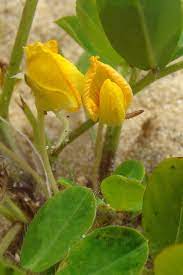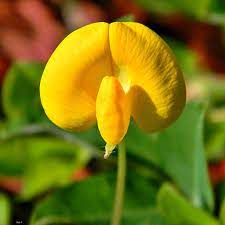Groundnuts/Peanuts Flowers also known as peanuts (Arachis hypogaea), produce unique and fascinating flowers as part of their reproductive process. Here’s a description of groundnut/peanut flowers:
Groundnut flowers are small, delicate, and typically yellow in color. They are usually around 1 to 1.5 centimeters in length and grow in clusters near the base of the plant.
Each flower consists of a slender, tubular corolla with four petals, which form a shape resembling a butterfly when viewed from the top. Two petals are upright and joined together, while the other two are smaller and spread out, forming the “wings” of the butterfly shape.
Groundnut flowers are self-pollinating, meaning they have both male and female reproductive organs. The flowers have a unique feature where the ovary, the female part, is located below the ground. After pollination, the ovary develops into a “peg” that grows downward into the soil. Here, the peanut seeds develop and mature, leading to the peculiar phenomenon of peanuts growing underground.
While groundnuts are capable of self-pollination, they can also be pollinated by insects, particularly bees, which play a vital role in their reproduction. When a bee lands on the flower to collect nectar, the flower’s structure allows the bee to come into contact with both the male and female parts, facilitating the transfer of pollen and fertilization.
The life cycle of groundnut plants is relatively short, and the flowers bloom for a short period. Once fertilized, the flower withers, and the peg starts growing downwards, burying the developing seeds into the ground.
Groundnuts are an essential crop worldwide, providing a significant source of protein, healthy fats, and other nutrients in many diets. The flowers play a crucial role in the production of peanuts, contributing to the cultivation of this valuable and widely consumed legume.
Overall, groundnut/peanut flowers exhibit an interesting combination of unique features that allow for self-pollination, but they also benefit from the assistance of pollinators like bees, ensuring a successful reproductive process and the formation of the beloved peanuts we enjoy.
Economic Importance, Uses, and By-Products of Groundnuts/Peanuts Flowers

some economic of Groundnuts/Peanuts Flowers includes:
1. Food and Nutrition: Groundnuts are a valuable source of protein, healthy fats, vitamins (such as B vitamins and vitamin E), and minerals (like phosphorus, magnesium, and zinc). They are widely consumed as snacks, in peanut butter, and as ingredients in various cuisines around the world.
2. Cooking Oil: Groundnut oil is extracted from the seeds and is commonly used for cooking, frying, and in salad dressings due to its high smoke point and mild flavor.
3. Animal Feed: Groundnut by-products, such as peanut meal and peanut shells, are used as animal feed, providing a valuable source of protein and energy for livestock.
4. Medicinal Uses: Groundnuts contain bioactive compounds such as resveratrol and phytosterols, which have potential health benefits, including antioxidant and anti-inflammatory properties.
5. Industrial Applications: Peanut oil is utilized in the manufacture of soap, cosmetics, and pharmaceuticals.
6. Soil Improvement: Groundnuts are nitrogen-fixing plants, meaning they have a symbiotic relationship with specific bacteria that enrich the soil with nitrogen, improving soil fertility for subsequent crops.
Read Also : Economic Importance, Uses, and By-Products of Groundnuts/Peanuts Pegs
7. Biodiesel Production: Some research has explored using peanut oil for biodiesel production, providing an alternative and renewable energy source.
8. Pollination: Groundnut flowers play a vital role in the reproductive process of the plant, attracting pollinators such as bees, butterflies, and other insects. Pollination is crucial for the production of groundnut seeds, which are the primary economic product of the plant.
9. Biodiversity and Ecosystem Services: Groundnut flowers contribute to the overall biodiversity and ecosystem health of agricultural landscapes. A diverse ecosystem with a range of plant species, including groundnut, can improve soil fertility, pest control, and nutrient cycling, leading to more sustainable and productive agricultural systems.
10. Aesthetic and Landscape Value: In some cases, groundnut fields can be grown for ornamental or landscaping purposes, where the beauty of the flowering plants adds value to public spaces, gardens, and parks.
11. Traditional and Cultural Uses: Groundnut plants, including their flowers, may have cultural significance in certain regions. They might be used in traditional ceremonies, rituals, or as decorative elements during festivals and cultural events.
12. Research and Breeding: Studying the characteristics of groundnut flowers can be important for plant breeders and researchers working to improve crop yields, disease resistance, and other desirable traits. Understanding the flowering process can aid in developing better varieties and optimizing agricultural practices.
t’s essential to note that while the above points outline the various economic uses of groundnuts themselves, their flowers are not typically recognized for specific economic importance or direct uses in industries. The primary economic focus remains on the production and utilization of groundnut seeds and their derivatives.
In conclusion, while groundnut flowers may not have specific direct economic uses or applications, they play a crucial role in the plant’s reproductive cycle, contribute to ecosystem health, and may have cultural significance. The primary economic focus and value in groundnuts lie in their edible seeds and various products derived from them.
The Products and By-products That Can Be Derived From Groundnuts/Peanuts Flowers

The main parts of the groundnut plant include the flowers, pods, and seeds. Let’s explore the different products and by-products that can be derived from groundnut flowers:
1. Peanut Pods: The peanut pods are the outer shells that protect the seeds (kernels). After harvesting the groundnut plant, the pods can be used in different ways:
2. Animal Feed: Peanut pods can be fed to livestock and used as a component in animal feed to provide nutrition and roughage.
3. Peanut Oil: Peanut oil is extracted from the groundnut seeds, not the flowers, but it’s closely related to the overall groundnut processing. The flowers play a vital role in the pollination and production of the groundnut seeds that are later used for oil extraction. Peanut oil is widely used for cooking and as a base for various food products. The process of extracting peanut oil involves:
Read Also : Economic Importance, Uses, and By-Products of Groundnuts/Peanuts Roots
Harvesting: Groundnut pods are collected after maturity.
Shelling: Removing the seeds (kernels) from the pods.
Cleaning: Cleaning the seeds to remove any debris.
Roasting: Roasting the seeds to enhance the oil’s flavor and aroma.
Pressing: Crushing the roasted seeds to extract the oil.
Filtering and Refining: Filtering the oil to remove any remaining solid particles and refining it to improve its quality.
4. Peanut Meal/Cake: Peanut meal or cake is a by-product of the oil extraction process. After pressing the seeds to extract the oil, the remaining seed material is processed into a solid cake, which is high in protein and used as animal feed.
5. Peanut Shell Ash: Peanut shell ash is obtained by burning the peanut shells. The ash contains various nutrients like potassium, phosphorus, and calcium, making it suitable as a fertilizer or soil conditioner.
6. Peanut Shell Briquettes: Groundnut shells can be converted into briquettes through a process called carbonization. The briquettes can be used as a fuel source for heating and cooking.
7. Peanut Butter: Peanut butter is a popular spread made from groundnut seeds (kernels). After the seeds are roasted and their skins removed, they are ground into a smooth or crunchy paste, typically with added sweeteners and stabilizers. Peanut butter is widely consumed as a nutritious and tasty food product.
8. Peanut Flour: Peanut flour is produced by grinding roasted groundnut seeds (kernels) into a fine powder. It is often used as a gluten-free alternative to wheat flour in baking and as a protein supplement in various food products.
9. Peanut Candy: Groundnuts are frequently used to make various types of candies, such as peanut brittle and peanut clusters. These candies are made by combining roasted peanuts with sugar syrup and allowing them to cool and harden into delicious treats.
10. Peanut Milk: Similar to almond or soy milk, peanut milk is a plant-based alternative to dairy milk. It is made by blending groundnut seeds (kernels) with water and straining the mixture to obtain a milk-like liquid. Peanut milk can be used in cooking, baking, or enjoyed as a beverage.
11. Peanut Skin Extract: Peanut skins, the thin reddish-brown outer layer of the seeds, contain valuable antioxidants. The extraction of these antioxidants is being explored for potential applications in the food and pharmaceutical industries.
12. Peanut Vine Silage: The vines and foliage of the groundnut plant, after the pods have been harvested, can be used to produce silage. Silage is a fermented feed that serves as a valuable animal feed during periods of scarcity or as supplementary feed.
13. Peanut Shell Mulch: Groundnut shells can be crushed and used as mulch for gardening and farming. The mulch helps retain soil moisture, suppress weeds, and improve soil health.
14. Peanut Husk Fiber Products: The husk, a papery layer surrounding the seeds within the pods, can be processed into fiber. This fiber can be used to make various products like mats, baskets, and even bio-composites for eco-friendly packaging materials.
It’s important to note that some of the products listed above might not be as common or widely known as others, and their production and utilization might vary regionally based on local practices and demand. Groundnut/peanut plants are valuable resources that offer multiple products and by-products, making them an essential crop in agriculture and various industries.
Read Also : Importance Of Green Farming
